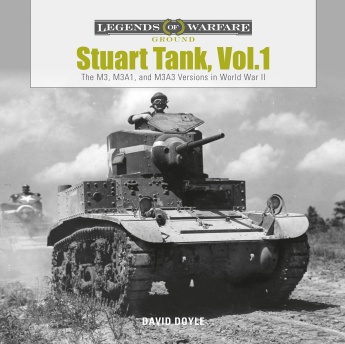|
|
|
|
Stuart Tank, Vol. 1
The M3, M3A1 and M3A3 Versions in World War II
Reviewed by Peter Brown
Summary
Title: |
Stuart Tank, Vol. 1 The M3, M3A1 and M3A3 Versions in World War II Legends of Warfare: Ground, 9 by David Doyle Schiffer Books, Atglen, PA USA |
ISBN: |
978-0-7643-5660-5 |
Price: |
US$18.50; GBP18.99 |
Review Type: |
First Read |
Advantages: |
Good source material. |
Disadvantages: |
None noted |
Recommendation: |
Lots of clear photos, informative text |
FirstRead
While this is not a new book - it was released in 2019 - I have not seen it reviewed and with the new MiniArt kit just out and maybe more M3's to come I thought it worth bringing to your attention.
While they were overshadowed by Medium Tanks such as the M4 Sherman, American Light Tanks played an important part in WW2. The M3 Stuart (to use its British name) evolved from a series of Light Tanks developed in the 1930s. It went through several variations including the M3, M3A1 and M3A3 models. All used the same suspension, engine and drive which were well proven and reliable. Their 37mm guns and armour protection were adequate when first introduced though later outclassed.
The M3 was the first American tank to see action during the war years, first with the British Army in North Africa and shortly afterwards with the US Army in the Philippines.
Originally it was mainly of riveted construction but gradually more and more welding was used. It carried five machine guns with one on the back of the turret for defence against aircraft. The fixed ones in the sponsons were often removed. While the hull design remained the same with large access hatches for the hull crew in the front, several turret types were fitted. Original models used a hexagonal welded version which was soon replaced by the same design welded. Then a new design based on a rounded rear was brought in and finally the large cupola was not fitted. Towards the end of production the upper hulls were welded.
M3A1 featured improved gun control including a stabiliser and a turret basket for the crew with the upper hull welded. The fixed machine guns in the hull were not fitted. Final type was the M3A3 which new designs of hull and turret, the former with a sloping front and sides with hatches in the hull top for the driver and co-driver while the latter was a completely new design with a large bustle at the rear for the radio. These were all passed to Allied nations via Lend-Lease.
This book briefly covers the inter-war designs before going into great detail on the M3 series themselves. This includes excellent period black and white photos of each model including close-ups and also colour photos of surviving tanks. Use in action is not dealt with in as much detail although the principle users are all there.
Overall a very useful reference book on these tanks for modellers and those interested in WW2 tank designs. David Doyle is to be congratulated for finding an excellent collection of photos and presenting the development in concise, readable text backed by extensive captions.
A separate book covers the M5, M5A1 and M8 series.
Peter Brown for Brett Green, 18 April 2024

